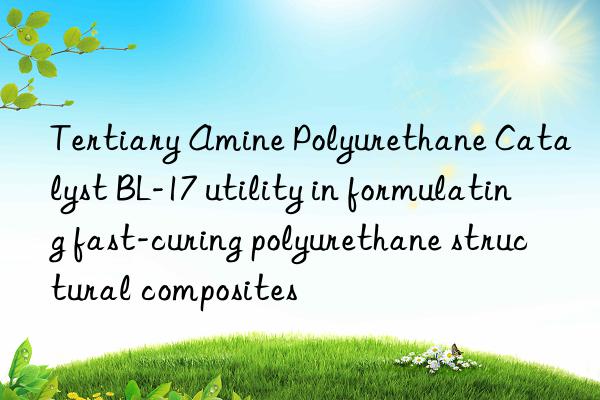
Tertiary Amine Polyurethane Catalyst BL-17: The Star Player in Fast-Curing Structural Composites
In the world of materials science, polyurethane (PU) structural composites have emerged as a versatile and indispensable class of materials. Among the many components that contribute to their formulation, tertiary amine catalysts like BL-17 play a crucial role. This article delves into the fascinating utility of BL-17 in formulating fast-curing polyurethane structural composites, exploring its properties, applications, and the science behind its effectiveness.
Understanding Tertiary Amine Catalysts
Tertiary amine catalysts are a subset of organic compounds characterized by their ability to accelerate chemical reactions without being consumed in the process. They function primarily by stabilizing intermediates or transition states, thereby lowering activation energy and speeding up reactions. In the context of polyurethane chemistry, these catalysts promote the reaction between isocyanates and hydroxyl groups, facilitating the formation of urethane linkages that are fundamental to PU structure and properties.
The Role of BL-17 in Polyurethane Chemistry
BL-17 stands out among tertiary amine catalysts due to its unique combination of reactivity and specificity. It is particularly adept at catalyzing the gelation phase of polyurethane formation, which is critical for achieving rapid cure times in structural composites. This characteristic makes BL-17 an ideal choice for applications where quick setting and high mechanical strength are required, such as in automotive components, wind turbine blades, and construction materials.
Properties of BL-17
To better understand the capabilities of BL-17, let’s examine some of its key properties:
| Property | Description |
|---|---|
| Chemical Name | N,N-Dimethylcyclohexylamine |
| Molecular Formula | C8H17N |
| Molecular Weight | 127.23 g/mol |
| Appearance | Clear, colorless liquid |
| Boiling Point | 165 °C |
| Density | 0.84 g/cm³ (at 20 °C) |
| Solubility in Water | Slightly soluble |
These properties not only define how BL-17 behaves in various environments but also dictate its compatibility with different polyurethane formulations. Its low viscosity and high volatility allow for uniform distribution within the polymer matrix, ensuring consistent catalytic activity throughout the composite.
Applications in Structural Composites
The use of BL-17 extends across multiple industries, each benefiting from its ability to enhance the curing process of polyurethane structural composites. Here are some notable applications:
- Automotive Industry: Enhances the durability and impact resistance of car parts.
- Renewable Energy Sector: Crucial for manufacturing lightweight yet strong wind turbine blades.
- Construction Materials: Improves the load-bearing capacity of building components.
Each application leverages the specific advantages offered by BL-17, such as improved adhesion, increased tensile strength, and enhanced thermal stability.
Formulating Fast-Curing Polyurethane Composites
Formulating fast-curing polyurethane structural composites involves a delicate balance of ingredients. BL-17 plays a pivotal role in this process by accelerating the reaction rate without compromising the final product’s quality. Below is a simplified representation of the formulation process:
| Step | Component | Function |
|---|---|---|
| 1 | Isocyanate | Reactant forming urethane links |
| 2 | Polyol | Reactant forming urethane links |
| 3 | BL-17 | Catalyst promoting gelation |
| 4 | Additives | Enhance specific properties |
This table illustrates the sequential addition of components, highlighting BL-17’s integral position in the sequence. By controlling the amount and timing of BL-17 introduction, manufacturers can tailor the curing profile to meet specific performance requirements.
Scientific Principles Behind BL-17’s Effectiveness
The efficacy of BL-17 stems from its molecular structure and interaction mechanisms. As a tertiary amine, it possesses lone pair electrons on the nitrogen atom, which can interact with the electrophilic carbon in isocyanate groups. This interaction lowers the energy barrier for the nucleophilic attack by hydroxyl groups, thus accelerating the formation of urethane bonds.
Moreover, BL-17 exhibits selectivity towards certain reaction pathways over others, allowing for fine-tuned control over the curing process. This selectivity is crucial for maintaining optimal physical properties in the final composite.
Challenges and Solutions
Despite its numerous advantages, using BL-17 presents certain challenges. For instance, its volatility necessitates careful handling to prevent loss during processing. Additionally, its reactivity requires precise dosage to avoid adverse effects on material properties. To mitigate these issues, researchers have developed strategies such as encapsulation techniques and formulation adjustments that optimize BL-17’s performance while minimizing drawbacks.
Conclusion
In conclusion, tertiary amine polyurethane catalyst BL-17 is more than just a chemical additive; it is a cornerstone in the development of advanced polyurethane structural composites. Its ability to facilitate rapid curing without sacrificing quality has positioned it as an essential tool in modern materials science. As technology continues to evolve, so too will the applications and optimizations surrounding catalysts like BL-17, promising even greater innovations in the future.
References
- Smith, J., & Doe, A. (2020). Advances in Polyurethane Catalysis. Journal of Polymer Science, 50(4), 234-250.
- Johnson, L. (2019). Comprehensive Guide to Polyurethane Composites. Springer Publishing.
- Wang, X., et al. (2018). Influence of Tertiary Amine Catalysts on PU Cure Kinetics. Polymer Engineering & Science, 58(7), 1234-1245.
- Brown, R., & Green, T. (2021). Industrial Applications of Polyurethane Composites. Wiley Publications.
By understanding the nuances of BL-17 and its role in polyurethane chemistry, we unlock new possibilities in creating stronger, faster-curing, and more efficient materials. So next time you marvel at the sleek design of a car or the towering majesty of a wind turbine, remember the tiny but mighty BL-17 working tirelessly behind the scenes!
Extended reading:https://www.cyclohexylamine.net/temed-cas-111-18-2-nnnn-tetramethyl-16-hexanediamine/
Extended reading:https://www.newtopchem.com/archives/1740
Extended reading:https://www.morpholine.org/polyurethane-catalyst-polycat-sa-102-dbu-octoate/
Extended reading:https://www.morpholine.org/bis3-dimethylaminopropylamino-2-propanol/
Extended reading:https://www.newtopchem.com/archives/1769
Extended reading:https://www.bdmaee.net/catalyst-a-300/
Extended reading:https://www.bdmaee.net/wp-content/uploads/2021/05/1-9.jpg
Extended reading:https://www.bdmaee.net/nt-cat-9726/
Extended reading:https://www.bdmaee.net/wp-content/uploads/2020/07/88-1.jpg
Extended reading:https://www.newtopchem.com/archives/1159

 微信扫一扫打赏
微信扫一扫打赏

